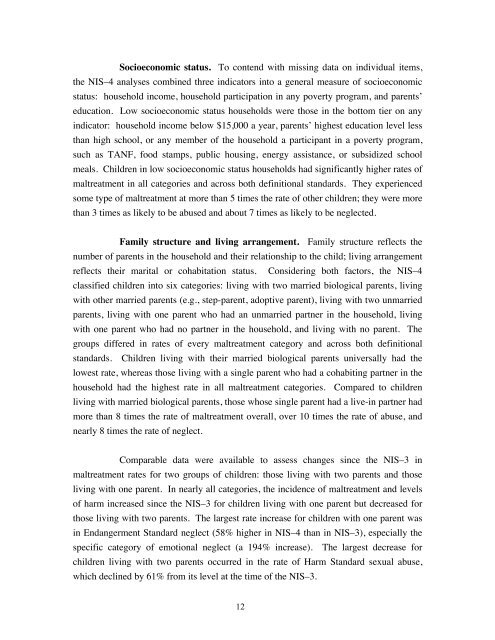National Incidence Study of Child Abuse and ... - Children's Central
National Incidence Study of Child Abuse and ... - Children's Central
National Incidence Study of Child Abuse and ... - Children's Central
- No tags were found...
You also want an ePaper? Increase the reach of your titles
YUMPU automatically turns print PDFs into web optimized ePapers that Google loves.
Socioeconomic status. To contend with missing data on individual items,the NIS–4 analyses combined three indicators into a general measure <strong>of</strong> socioeconomicstatus: household income, household participation in any poverty program, <strong>and</strong> parents’education. Low socioeconomic status households were those in the bottom tier on anyindicator: household income below $15,000 a year, parents’ highest education level lessthan high school, or any member <strong>of</strong> the household a participant in a poverty program,such as TANF, food stamps, public housing, energy assistance, or subsidized schoolmeals. <strong>Child</strong>ren in low socioeconomic status households had significantly higher rates <strong>of</strong>maltreatment in all categories <strong>and</strong> across both definitional st<strong>and</strong>ards. They experiencedsome type <strong>of</strong> maltreatment at more than 5 times the rate <strong>of</strong> other children; they were morethan 3 times as likely to be abused <strong>and</strong> about 7 times as likely to be neglected.Family structure <strong>and</strong> living arrangement. Family structure reflects thenumber <strong>of</strong> parents in the household <strong>and</strong> their relationship to the child; living arrangementreflects their marital or cohabitation status. Considering both factors, the NIS–4classified children into six categories: living with two married biological parents, livingwith other married parents (e.g., step-parent, adoptive parent), living with two unmarriedparents, living with one parent who had an unmarried partner in the household, livingwith one parent who had no partner in the household, <strong>and</strong> living with no parent. Thegroups differed in rates <strong>of</strong> every maltreatment category <strong>and</strong> across both definitionalst<strong>and</strong>ards. <strong>Child</strong>ren living with their married biological parents universally had thelowest rate, whereas those living with a single parent who had a cohabiting partner in thehousehold had the highest rate in all maltreatment categories. Compared to childrenliving with married biological parents, those whose single parent had a live-in partner hadmore than 8 times the rate <strong>of</strong> maltreatment overall, over 10 times the rate <strong>of</strong> abuse, <strong>and</strong>nearly 8 times the rate <strong>of</strong> neglect.Comparable data were available to assess changes since the NIS–3 inmaltreatment rates for two groups <strong>of</strong> children: those living with two parents <strong>and</strong> thoseliving with one parent. In nearly all categories, the incidence <strong>of</strong> maltreatment <strong>and</strong> levels<strong>of</strong> harm increased since the NIS–3 for children living with one parent but decreased forthose living with two parents. The largest rate increase for children with one parent wasin Endangerment St<strong>and</strong>ard neglect (58% higher in NIS–4 than in NIS–3), especially thespecific category <strong>of</strong> emotional neglect (a 194% increase). The largest decrease forchildren living with two parents occurred in the rate <strong>of</strong> Harm St<strong>and</strong>ard sexual abuse,which declined by 61% from its level at the time <strong>of</strong> the NIS–3.12
















